In the Weeds: Trees
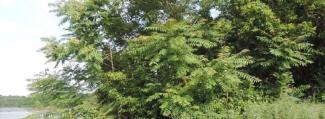
The roots of fast-growing trees like the stand of Tree-of-Heaven above can damage the underlying structures of vegetated stormwater systems. Click on the plant names below to open a dropdown with images and more information about each of these common GI invaders.
Scientific name: Robinia pseudoacacia
Status: Native and weedy
This tree is native to the southeastern part of the U.S. It has compound leaves with smooth edges, white flowers that form seedpods, and reddish thorns that grow from the trunk and branches.
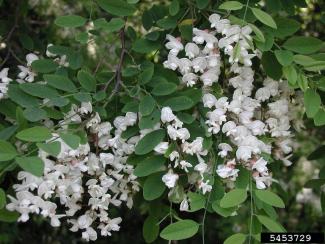
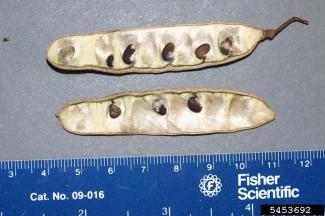
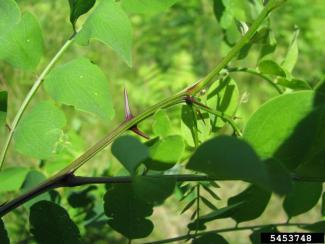
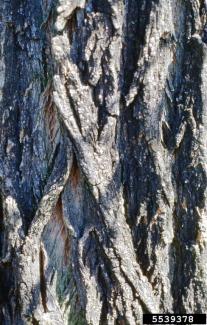
Photo credit: (First, second, third) Leslie J. Mehrhoff, University of Connecticut, Bugwood.org, (fourth) T. Davis Sydnor, The Ohio State University, Bugwood.org.
Callery Pear
Pyrus calleryana
Invasive
Has vase-shaped growth form, and many white flowers that bloom early in spring. Leaf blade is simple and edge of leaf is smooth. Leaves are arranged opposite.
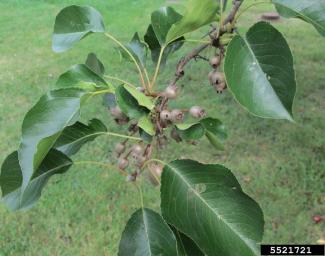
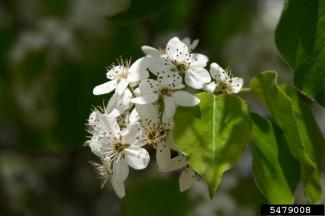
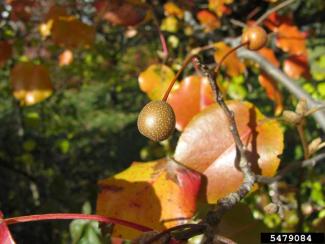
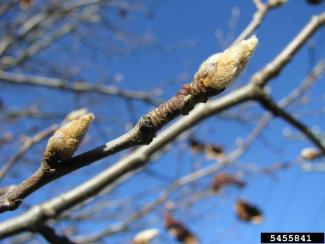
Photo credit: (First) David Stephens, Bugwood.org, (second, third, fourth) Leslie J. Mehrhoff, University of Connecticut, Bugwood.org.
Acer ginnala
Invasive
Has longer leaves compared to most other maples. Bark of adult plant is thin and mostly smooth. Native Red maples have similarly-sized leaves that are a much shorter shape. Leaves are arranged opposite.

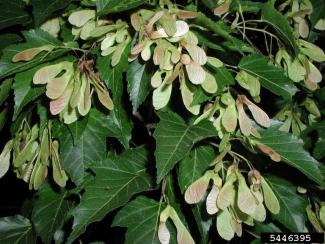
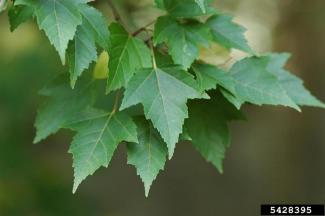
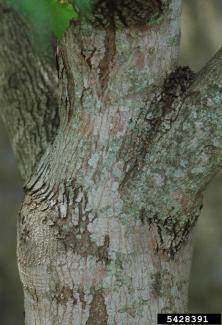
Photo credit: (First, second) Leslie J. Mehrhoff, University of Connecticut, Bugwood.org, (third, fourth) Karan A. Rawlins, University of Georgia, Bugwood.org.
Norway Maple
Acer platanoides
Invasive
Tell apart from a Sugar maple in winter by larger, plumper cherry-brown buds (see first image below). During growing season, plucking leaf stem off of branch will cause a bead of white sap to appear on the node of a Norway maple. Adult plants have evenly-ridged gray bark. Leaves are arranged opposite.
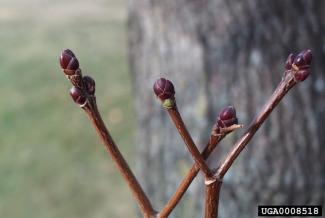
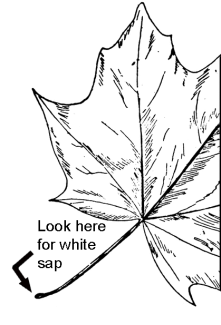
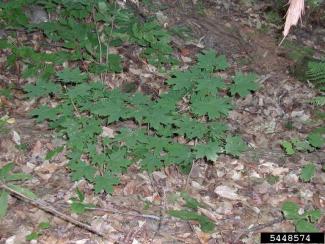
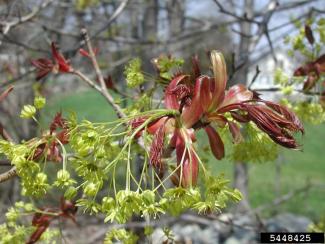

Photo credit: (First) Paul Wray, Iowa State University, Bugwood.org, (second) Clipart courtesy FCIT, (third, fourth) Leslie J. Mehrhoff, University of Connecticut, Bugwood.org, (fifth) David Stephens, Bugwood.org.
Sycamore Maple
Acer pseudoplatanus
Invasive
Bark is scaly and flakes away leaving orange patches. Leaves are thick and leathery. Buds stay green throughout the winter. Leaves are arranged opposite. Plump buds are greenish in winter.
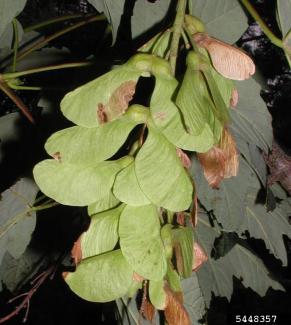
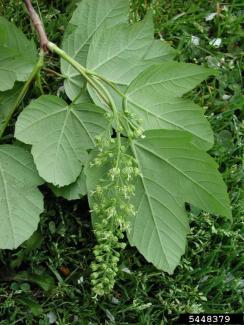
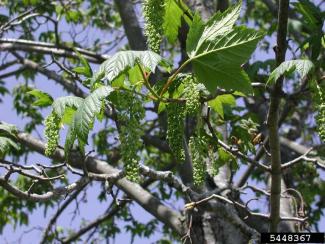

Photo credit: Leslie J. Mehrhoff, University of Connecticut, Bugwood.org.
Princess Tree
Paulownia tomentosa
Invasive
A fast-growing tree. Sweet-smelling purple flowers are produced early in spring. On young trees the leaves can look similar to those of native catalpa tree—check to see if leaves rise from stem in a whorl (catalpa) or opposite (princess tree).
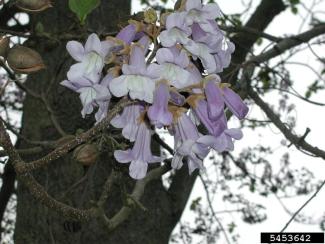
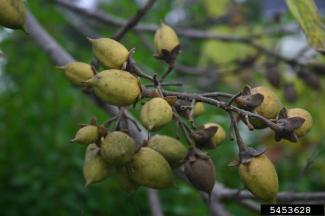
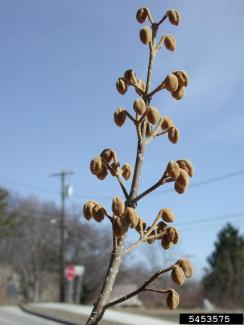
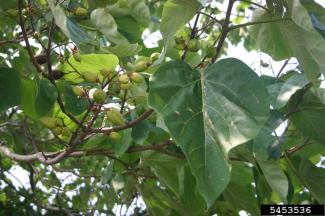
Photo credit: Leslie J. Mehrhoff, University of Connecticut, Bugwood.org.
Tree-of-Heaven
Ailanthus altissima
Invasive
Fast-growing tree with large compound leaves. All parts of the plant have an unpleasant smell. It can be a challenge to tell tree-of-heaven apart from native sumac plants, so use the following methods. Observing whether bark has horizontal (sumac) or vertical (tree-of-heaven) patterning—see tree-of-heaven in fourth picture below. The sap of tree-of-heaven is clear. To identify tree-of-heaven in the early spring and winter, look for a shield-shaped leaf scar as seen in the fifth picture below. When leaves are out, notice that tree-of-heaven leaflets have notched bases, as seen in the final photo below.
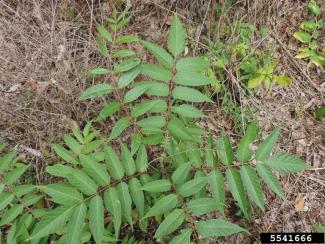
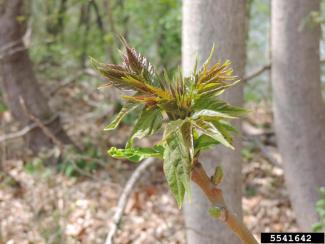
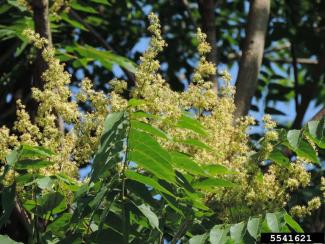
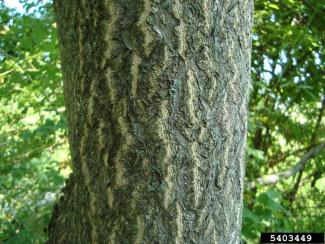
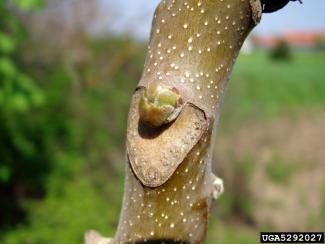
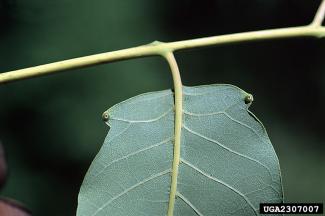
Photo credit: (First, second, third) Richard Gardner, UMES, Bugwood.org, (fourth) Annemarie Smith, ODNR Division of Forestry, Bugwood.org, (fifth) Jan Samanek, Phytosanitary Administration, Bugwood.org, (sixth) James H. Miller, USDA Forest Service, Bugwood.org.
White Poplar
Populus alba
Invasive
Leaves have three lobes and appear bright silver-white on underside. Buds and young leaves are also silver-white. Shallow roots. Bark on mature plant can be both smooth and thin or ridged and thick. Big-toothed aspen is a native look-alike, but its leaves are not white underneath.
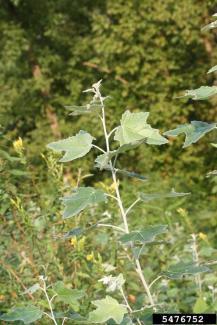
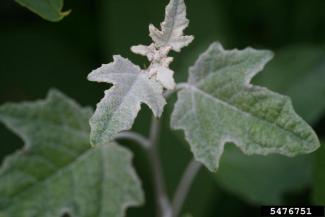
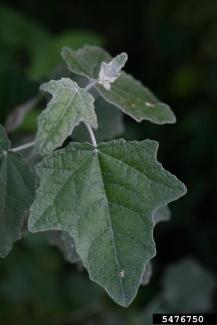
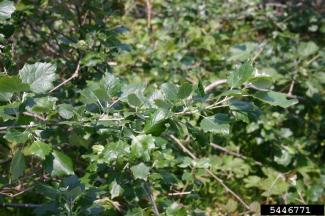
Photo credit: (First) Chris Evans, University of Illinois, Bugwood.org, (second, third) Wendy VanDyk Evans, Bugwood.org, (bottom) Leslie J. Mehrhoff, University of Connecticut, Bugwood.org.
Descriptions for Black Locust, Callery Pear, Amur Maple, Norway Maple, Sycamore Maple, and White Poplar from New England Wild Flower Society. www.newenglandwild.org & www.gobotany.newenglandwild.org
Descriptions for Princess Tree and Tree-of-Heaven referenced from https://extension.umd.edu/hgic
